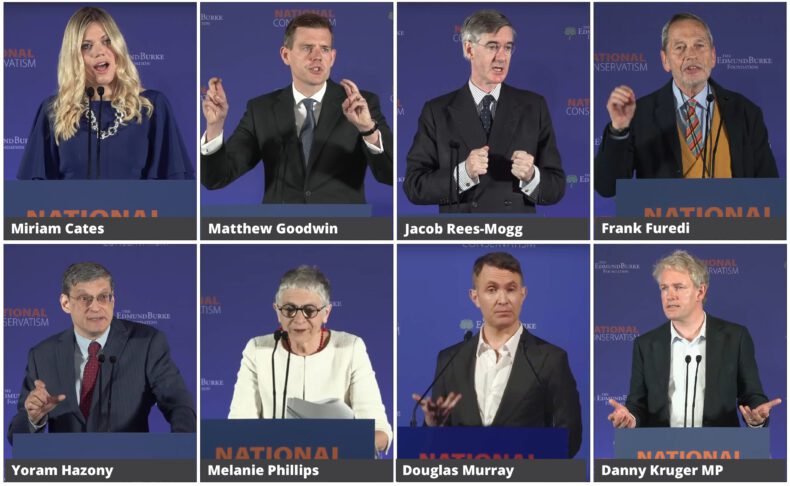Concerns over falling birth rates and high immigration loomed large at the recent National Conservatism conference in London. Star turn, Conservative MP Miriam Cates, is exercised by both. But what’s the connection? David Edgar sifts through the rhetoric
First published in the Summer 2023 issue of Searchlight magazine

Credit: National Conservatism You Tube channel
The two big stories to emerge from the National Conservatism conference in London in May were Jacob Rees-Mogg’s admission that voter ID was an attempt at gerrymandering (unsuccessful from his point of view, as it suppressed the older Conservative vote), and Douglas Murray’s claim that nazism was merely ‘mucking up’ patriotism (‘I don’t see why no one should be allowed to love their country because the Germans mucked up twice in a century’).
The NatCon conference was organised by the Edmund Burke Foundation (EBF), set up in 2019 by far-right Israeli philosopher Yoram Hazony around a ‘Statement of Principles’, which begins: ‘We are citizens of Western nations who have watched with alarm as the traditional beliefs, institutions, and liberties underpinning life in the countries we love have been progressively undermined and overthrown.’
Often ill-attended, the conference’s speakers included the ambitious Home Secretary Suella Braverman and the jaded Michael Gove, two noted national-populist advocates (Matthew Goodwin and David Goodhart), the former Trotskyite and now Viktor Orbán-apologist Frank Furedi and – receiving the biggest ovation – the former feminist Melanie Phillips. But perhaps the most ideologically innovative contribution was made by backbench Conservative MP Miriam Cates.
Stating that she did not care if she was addressing ‘a Red Tory, a communitarian, a follower of Burke, or, heaven forbid, a libertarian free marketer’, she insisted that ‘the one overarching threat to British conservatism and, indeed, the whole of Western society’, was not climate change, Russia, China or Iran, or even ‘the neo-Marxist ideology that has so weakened our institutions’. No, she insisted, there was one ‘critical outcome that liberal individualism has completely failed to deliver’: babies.
This position is not surprising from Cates, who is an evangelical Christian who has opposed so-called censorship zones around abortion clinics (to protect patients from abuse), denies the possibility of changing sex, and campaigns against aspects of sex education. Until 2018, she was on the board of a Sheffield church that practised ‘conversion therapy’ of gay people (although she denied knowledge), and she co-founded the socially conservative New Social Covenant Unit with Boris Johnson’s former political secretary Danny Kruger MP.
Kruger told the NatCon conference that Conservatives faced a ‘new religion’, mixing ‘Marxism, narcissism and paganism’, and the ‘dystopian fantasy of John Lennon’ (Marxist-Lennonism?). He also insisted that heterosexual marriage was the ‘only possible basis for a safe and successful society’. On 3 July, Cates and Kruger launched a new pressure group of Red Wall Conservative MPs, titled the New Conservatives, to campaign for a dramatic reduction in immigration. Significantly, Cates’s justification for reducing immigration is to ‘restore democratic, cultural and economic security’.
As a faith, flag and family Conservative, Cates criticised ‘the indoctrination of our children with destructive and narcissistic ideologies’ (instead of ‘teaching them how to love our country’). She supports a family wage, which will discourage mothers from working, and opposes the liberalisation of divorce.
Despite views expressed elsewhere, Cates’s speech did not specifically blame what the EBF statement calls ‘a marked decline in marriage and childbirth’ on the encouragement of ‘ever more radical forms of sexual license and experimentation’. Her target here was not so much sexual permissiveness as the demographic threat.
Cates is not the only NatCon speaker to be concerned about the lowering of the domestic birth rate. In June, national-populist analyst-turned-activist Goodwin tweeted the same statistic quoted by Cates (that in 2021 the birth rate for England and Wales had fallen to 1.55 children per woman, according to data from the Office for National Statistics), noting that the rate is ‘lowest among the most highly educated women’.
In this, he perhaps unconsciously evoked the 1974 speech by (then) Conservative leadership hopeful Sir Keith Joseph, in which he claimed that ‘our human stock is threatened’ by the high proportion of births to ‘mothers least fitted to bring children into the world’, in social classes 4 and 5. But Goodwin’s main point is about how the domestic birth rate relates to immigration. In a Substack summary of his much (self) hyped new book Values, Voice and Virtue, Goodwin points out that ‘ …as Britain’s fertility rate dropped below the “replacement rate” of 2.1’, immigration and ‘higher fertility rates among young migrants made immigration the main driver of population growth’. (Substack 20 April 2023). No surprise that Goodwin agrees with Cates’s demand for a dramatic reduction in immigration.
Both also claim that immigration is being encouraged. Cates insists that one cause of the demographic crisis is an insistence by ‘the liberal elite’ that women should ‘derive more fulfilment from a paid job – any job – than they do from nurturing their own children’. Elsewhere, she pits ‘common sense conservatism’ against ‘the Westminster – or Global – elite’. (The first New Conservatives press conference was peppered with references to the ‘establishment’ and the ‘liberal elite’).
In his NatCon speech, Goodwin referred to ‘a new and deeply narcissistic elite minority’ (narcissism again) imposing a ‘radical and rampant cultural liberalism’ on an unwilling majority. Goodwin’s book reiterates time and again that this new elite (sometimes consisting of Russell Group university graduates, sometimes of the entire graduate class) is promoting ‘radical progressive’ values, including – of course – feminism and immigration.
No surprise that Cates, too, thinks that far too many young people are going to university, a concern also expressed by Joseph in his 1974 speech. Elsewhere, though not in his book, Goodwin links his new elite with ‘multinational firms’ indulging in ‘woke capitalism’, in an ‘informal alliance between white elites, corporations and minorities, against the white working-class’ (Daily Mail 2 April 2021).
Thus Cates and Goodwin join a growing contemporary and historical move to blame changes in the structures of family life, and some of the factors (like liberalised divorce and abortion laws and the decriminalisation of homosexuality) that are claimed to have contributed to it, on a university-educated elite.
Cultural policy
For Goodwin, this elite is in cahoots with multinational companies. The idea that global capitalists are deliberately encouraging immigration not just as a source of cheap labour, but also as part of a cultural policy to undermine nationality is the thrust of the electorally successful ideology of Hungary’s now four-term Prime Minister Orbán, a model defined by Goodwin in his earlier volume National Populism (co-authored with Roger Eatwell).
Orbán, say Eatwell and Goodwin, asserts that ‘liberal politicians within the EU [European Union], along with the billionaire Hungarian-Jewish financier George Soros, are engaged in a plot to flood Hungary and “Christian” Europe with Muslim immigrants and refugees, which they see as part of a quest to dismantle Western nations and usher in a borderless world that is subservient to capitalism’.
The demographic decline of the Hungarian population is now central to the Orbán model. Cates criticises her government for imposing a two-child limit on those claiming welfare; the Hungarian government has instituted a lifetime tax break for women bearing four or more children, a cash incentive for large families to buy seven-seater cars and a ‘baby expecting loan’ of 10 million forints (£25,000), which couples can apply for if they promise to have children later on. As Sophia Siddiqui argued in Race & Class (October-December 2021), ‘the “birth-rate agenda” creates a space for anti-immigrant, demographic and ideologically anti-feminist agendas to converge’.
Addressing the Third Budapest World Conference of Demography (no less) in September 2019, Orbán painted an apocalyptic picture of the Hungarian population disappearing off the face of the map. Connecting this possibility with a version of the notorious Great Replacement Theory promoted by the far right on both sides of the Atlantic, Orbán asserted that ‘if Europe is not going to be populated by Europeans … then we are speaking about an exchange of populations, to replace the population of Europeans with others’.
He then went on to connect replacement to the conspiracy theory: ‘There are political forces in Europe who want a replacement of population for ideological or other reasons.’ Clearly, those forces include the supranational, liberal EU and Soros. In July 2022, Orbán repeated the assertion, insisting ‘the first and most important challenge … continues to be population, or demography’. The second challenge ‘is migration, which you could call population replacement or inundation’. And who is responsible? ‘Brussels, reinforced with Soros-affiliated troops, simply wants to force migrants on us’.
Eatwell and Goodwin acknowledge that the idea of international financiers plotting to destroy nation states by flooding them with immigrants is a version of ‘anti-Semitic conspiracy theory’, which makes it all the more striking when they assert that the claims of some of the conspiratorialists ‘are not entirely without credence’.
Of course, Goodwin’s version of the theory – corporations plus white liberals allying with migrants against the white working class – does not imply that the conspirators are Jewish. Nor, in bald fact, did Donald Trump’s claim (in a speech in Florida in 2016) that ‘Hillary Clinton meets in secret with international banks to plot the destruction of US sovereignty, in order to enrich those global financial powers’ specify the bankers’ race.
But compare both the content and the tone of these two statements:
‘Our corrupt political establishment, that is the greatest power behind the efforts at radical globalisation and the disenfranchisement of working people. Their financial resources are virtually unlimited, their political resources are unlimited, their media resources are unmatched.’
And this:
Through the Press, we have gained the power to influence while remaining ourselves in the shade: thanks to the Press we have got the gold in our hands.’
Conspiracy
The first is from the same Trump speech in Florida; the second is from the fake ‘Protocols of the Elders of Zion’, the Tsarist secret police forgery that outlined a Jewish plot to destroy the national states and impose a one world tyranny. At its core is a sinister alliance between Jewish finance capital and the left:
‘Nowadays, with the destruction of the aristocracy, the people have fallen into the grips of merciless money-grinding scoundrels who have laid a pitiless and cruel yoke upon the necks of the workers. We appear on the scene as the alleged saviours of the worker from this oppression and we suggest that he should enter the ranks of our fighting forces – Socialists, Anarchists, Communists – to whom we always give support.’
Used by the Nazis to justify the Holocaust, this theory reappears throughout the 20th century, in a variety of forms. In late 1950s America, the John Birch Society claimed that ‘both the US and Soviet governments are controlled by the same furtive conspiratorial cabal of internationalists, greedy bankers and corrupt politicians’, identifying the United Nations, the International Monetary Fund and international bodies such as the Bilderberg Group as agents of the conspiracy.
In the early 1970s, Bircher Gary Allen claimed that Middle America was being attacked from above by bankers and from below by student revolutionaries and the Black Panthers (‘We are going to have a dictatorship of the elite disguised as a dictatorship of the proletariat’). AK Chesterton, pre-war fascist and first National Front chair, wrote a conspiratorial tract called the New Unhappy Lords, with a chapter headed ‘Is the conspiracy Jewish?’ (his answer was ‘yes’).
In the same year as his notorious anti-immigration ‘Rivers of Blood’ speech, Enoch Powell MP claimed that ‘conspirators sit in the seats of the mighty, at the desks of ministers and editors’. In 1970, he argued that the British people ‘have been misled, cruelly and persistently, till one begins to wonder if the Foreign Office was the only Department of State into which enemies of this country were infiltrated’. Powell cited student protesters and civil rights campaigners in Northern Ireland, alongside ‘combustible material of another kind’ – Britain’s immigrant population – ‘accumulated for years, and not without deliberate intention in some quarters’.
It would be wrong to accuse promoters of one element of the theory of thereby buying into the theory in its entirety. You can think that the liberal elite is encouraging a lowering of the birth rate without thinking that it is in alliance with global finance capital. You can assert that global finance encourages immigration without thinking it is a plot to undermine the nation state. But it is clear from history that a taste for one item on the conspiratorial menu can lead people to try another.
Over the past decade, versions of the theory – with or without specifically anti-Semitic overtones – have been pumped out by national-populists across Europe and north America.
Acquiescing in or even promoting a declining indigenous birth rate is just the latest in a series of phenomena blamed on opinion formers in thrall to – or consisting of – global financial elites. But in a time in which full-blown conspiracy theories are being trumpeted not just on social media and right-wing media outlets, but also by current, former or aspirant national leaders, promoting seemingly freestanding parts of the theory can prove a gateway drug to the whole.





